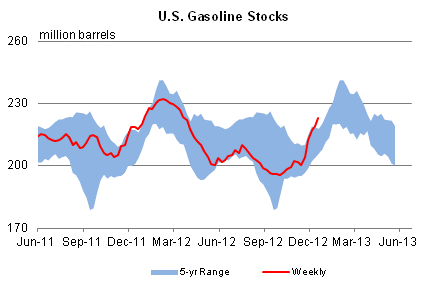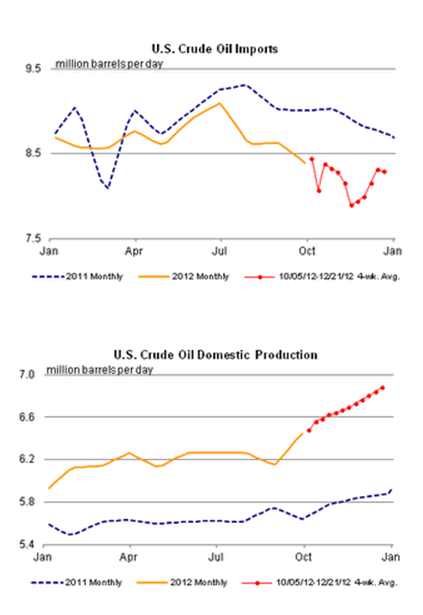Crude Oil & Gasoline Markets End 2012 with Swollen Inventory Levels
Commodities / Crude Oil Dec 30, 2012 - 10:11 AM GMTBy: EconMatters
 EIA Inventory Data
EIA Inventory Data
In analyzing the last EIA report of the year it is noteworthy that gasoline stocks really rose the last 5 weeks of the year. The takeaway isn`t so much that gasoline inventories rose 23 million barrels the last 5 weeks of the year, wow that is some build in inventories, but the fact that Oil inventories barely budged at all during the process.

Seasonal issues regarding tax selling in order to move as much oil through the system to avoid higher tax liabilities is primarily responsible for the higher run rates of refineries, and thus the build in gasoline inventories, but that should result in large drawdowns of oil as there is a push and pull between products and the base commodity oil. Yet we end the year slightly above the 370 million barrel mark in US oil inventories.
This is actually very bearish for oil because with these gasoline builds refineries are not going to want to keep adding more gas to storage as part of the reason refiners have done so much better with their margins is by keeping low inventory levels in the products so you have what appears to be a tight market.
Well, we no longer have a tight market in gasoline, so no need to draw as much crude to produce the end product. We should start to experience some rather substantial builds over the next couple of months in crude oil as refiners request less base commodity, and lower their run rates.
The Rise in Domestic Production
This occurrence really points to the rise in US domestic production as imports were fairly light during the last two months of the year, and we normally have substantial drawdowns with refinery run rates in the 90s, so something definitely worth paying attention to going forward into 2013.
Another point on imports and domestic production is that there is a very noticeable trend on the charts; imports have trended down after July, which is what one would expect after the summer driving season is coming to an end, but domestic production starts accelerating at a sharp right angle from July towards year-end.
So these are domestic projects that are strongly trending regardless of summer driving season demand, and unlike imports that are managed according to seasonal demand dynamics, i.e., Saudi Arabia pumps more or less depending upon the season, the domestic projects are just going full bore and on a production path to increase performance each and every month if possible.
This is something new to the market because we no longer have managed supply, just as Iraq is maximizing production right now because they need the revenue, well these domestic projects are just revenue based machines, and not being managed based upon supply and demand of the end market. I will provide two charts to illustrate this interesting phenomenon.

The Demand Picture
Another point to be made is what is happening with gasoline demand, down in the wholesale sector 2.8 percent year-on-year. With GDP being better than expected, and most believing that the economy is stronger than it was last year, this could be related to better fuel efficient vehicles on average in the US consumer fleet as the car sales were pretty good the last two years, and maybe higher prices changing driving behaviors on a more permanent basis.

The demand chart for 2012 can be explained by the run-up and actual summer driving season, with the inevitable falloff towards the end of the year. However, many analysts have forecast that the US being a mature country is going to trend down on a longer term basis from a demand standpoint, with most of the growth coming from emerging markets, but the year over year comparison is something worth paying attention to for 2013.
If we have a repeat deceleration in demand at the end of 2013 year comparisons then further analysis will be needed to identify potential additional reasons for slowing demand in an economy that is seemingly strengthening with a stronger housing and employment market.
Fundamentals versus Price
It would be great if Wall Street actually invested and traded based upon the fundamentals, but the oil markets have long since diverged from trading upon the fundamentals, especially in the short term, and are more ripe with “managing” price swings either through sophisticated algorithms, and “creative” fund flows than any notion of the fundamentals.
To put it non-euphemistically, basically the oil market has been rigged for years, like most markets to some extent, and is about as corrupt as it comes. All any bystander has to do is pull up a price ladder of bids and asks, known as a trading Dom, and watch all the large fake orders and other assorted order flow shenanigans used to manipulate price up and down the chart each day.
However, over the long term, the markets cannot stray too far from the fundamentals, for eventually the fundamentals take precedent over the trading shenanigans, especially if there is a definable, sustained trend in the fundamentals, and it appears that we are entering a new age where the world is going to have a five year period of abundant supply.
A New Era: Growing Economy with Lower Energy Prices
In fact, more supply than demand, even with a robust economy, because part of the reason the world economy will be doing so well is all the global enterprises out there producing oil. It’s a good business with very high margins when compared to many other industries with the past decade of higher prices.
Consequently, even if the US economy really takes off in 2013 as some have forecasted, don`t look for demand to overtake supply in the equation. The domestic oil renaissance means that we could have a booming economy, and still have more supply than we can use each day. Thus it is actually possible to have an era with a great economy, and even lower oil prices due to the domestic oil boom.
By EconMatters
The theory of quantum mechanics and Einstein’s theory of relativity (E=mc2) have taught us that matter (yin) and energy (yang) are inter-related and interdependent. This interconnectness of all things is the essense of the concept “yin-yang”, and Einstein’s fundamental equation: matter equals energy. The same theories may be applied to equities and commodity markets.
All things within the markets and macro-economy undergo constant change and transformation, and everything is interconnected. That’s why here at Economic Forecasts & Opinions, we focus on identifying the fundamental theories of cause and effect in the markets to help you achieve a great continuum of portfolio yin-yang equilibrium.
That's why, with a team of analysts, we at EconMatters focus on identifying the fundamental theories of cause and effect in the financial markets that matters to your portfolio.
© 2012 Copyright EconMatters - All Rights Reserved Disclaimer: The above is a matter of opinion provided for general information purposes only and is not intended as investment advice. Information and analysis above are derived from sources and utilising methods believed to be reliable, but we cannot accept responsibility for any losses you may incur as a result of this analysis. Individuals should consult with their personal financial advisors.
EconMatters Archive |
© 2005-2022 http://www.MarketOracle.co.uk - The Market Oracle is a FREE Daily Financial Markets Analysis & Forecasting online publication.



